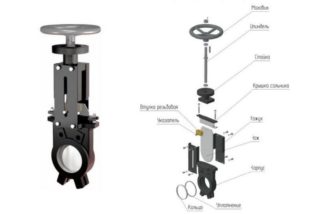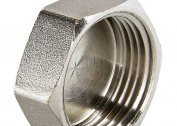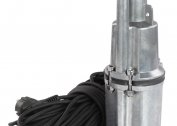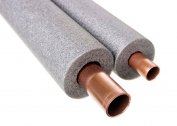A water valve is a shut-off element designed to completely stop the movement of water in a water supply network. Most highways with a cross section of 15 mm to 2 m are equipped with such devices for various liquids: water, oil products, as well as compressed air and bulk products.
Gate valve design
 Regardless of the type, all locking devices for the water supply system consist of the following elements:
Regardless of the type, all locking devices for the water supply system consist of the following elements:
- case part with cover;
- locking unit, which includes a guide and a shutter;
- a control element consisting of a valve, flywheel and threaded sleeve;
- yoke assembly for protection against aggressive environment and high temperature.
Devices are made of ductile iron and steel. They are fixed in the system due to flange or sleeve threaded (for pipes of small cross-section) connections.
Dimensions depend not only on the destination and type, but also on the material of manufacture. The standard diameter of cast iron products is from 40 to 2000 mm, the building length is from 140 to 550 mm. Corresponding dimensions in accordance with GOST for steel flanged gate valves: 50–1600 mm and 140–550 mm.
Operating principle
The pipeline valve works in this way:
- Manually or by means of an electric drive, the flywheel is moved, and after it the rod.
- The stem moves the shutter controlled by the guide.
- The shutter blocks the casing, creating an obstacle to the movement of fluid.
To open the shutter, turn the hand wheel in the opposite direction.
Do not use valves to adjust the water flow. This function is performed by special valves for water supply. In valves used not only for full overlap, steel or cast-iron parts with constant exposure to liquids will gradually wear out and will not be able to perform their work efficiently.
Types of reinforcing elements
Gate valves are divided into two types depending on the direction of action - parallel and perpendicular. The last type is stationary, moves at an angle of 90 degrees to the flow. Parallel devices are installed with a zero angle and do not create obstacles for the liquid, while they are in standard mode.
Reinforcing elements are classified according to the type of constipation:
- wedge;
- hose;
- gateways.
Stop valves also differ in the way the pipeline is shut off: with a retractable and non-retractable spindle. In the first version, the flywheel rotational translation is transmitted, the spindle is subsequently extended and the tube clearance is closed, in the second, the closure is carried out only by rotation.
In a separate category, it is possible to distinguish devices installed on equipment for extinguishing a flame. Fire dampers are inclined with an external thread or with a flange input and reduction.
Criterias of choice
Before purchasing a reinforcing element, determine what it will be used for: to completely shut off the water flow or to adjust it. After that, analyze the following indicators:
- mission and operating conditions: quality of the working environment, pressure maxima and temperature range;
- nominal value of conditional pass (ДУ);
- device control method;
- dimensions and methods of connecting to the pipeline;
- option overlapping device;
- suitable body material.
Cast iron gate valve is most often used for sewer pipelines, pipelines with compressed gas, steam and bulk products. For heating and water supply systems, locking elements made of steel are mainly used.
The cost of the device depends on the technical characteristics. The price range is very wide: gate valves can cost from 1,000 to 140,000 rubles. Prices for water control valves range from 1,000 to 500,000 rubles.
Mounting Features
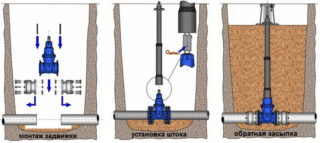 Stages of work when installing a reinforcing element on a plastic pipe:
Stages of work when installing a reinforcing element on a plastic pipe:
- Cut the pipe to the required length.
- On the soldering iron nozzles heated to 260 degrees put on a connecting branch pipe of a gate valve and an end face of a pipe.
- After heating, insert a pipe into the pipe.
- Allow the joint to cool and completely harden the plastic.
The flywheel can be located both above and from the side, but in no case from below.
If the line is metal, the installation depends on the type of connection of the valve. You will need to cut the threads at the ends of the pipe segments or weld the counter flanges.
The installation of electric valves on the water pipes has its own nuance. The element is mounted in any position except the bottom. If the spindle is located in a horizontal plane, additional support for the electric drive is needed.
The bulk of the valves cannot be repaired. Carefully monitor the condition of the valve and, if necessary, replace it with a new one.
